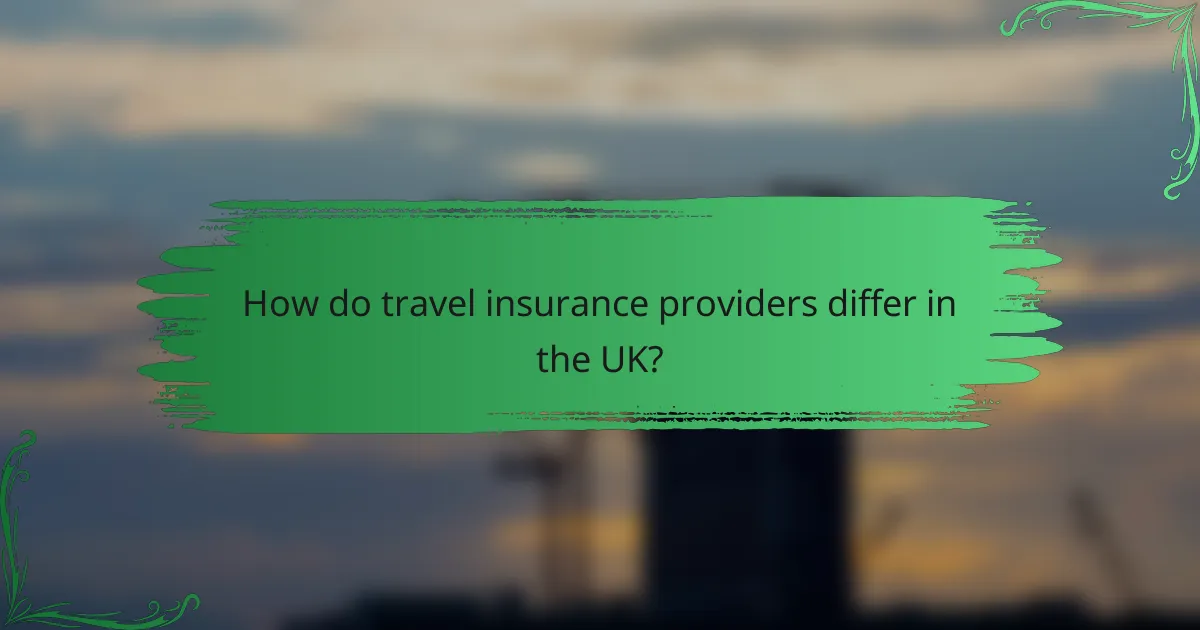Travel insurance is essential for safeguarding against unexpected events during your journey, and its cost can vary significantly based on several factors. Key considerations include the traveler’s age, destination, coverage level, trip length, and any pre-existing medical conditions. Longer trips typically incur higher premiums due to increased risk, while various coverage options are available to address specific needs, such as medical expenses and trip cancellations.

What factors influence travel insurance costs in the UK?
The cost of travel insurance in the UK is influenced by several key factors, including the age of the traveler, the destination country, the level of coverage selected, the duration of the trip, and any pre-existing medical conditions. Understanding these elements can help travelers make informed decisions and find suitable policies that fit their needs and budget.
Age of the traveler
Age significantly impacts travel insurance costs, as older travelers often face higher premiums. Insurers consider age a risk factor; those over 60 may see costs increase by a notable percentage compared to younger travelers.
For example, a 25-year-old might pay around £30 for a basic policy, while a 65-year-old could pay upwards of £70 for similar coverage. It’s essential to compare quotes from different providers to find the best deal.
Destination country
The destination country plays a crucial role in determining travel insurance costs. Policies for high-risk destinations, such as those with political instability or high medical costs, tend to be more expensive.
For instance, traveling to the USA may incur higher premiums due to the high cost of healthcare there, while trips to countries with lower healthcare costs could result in lower insurance rates. Always check the specific risks associated with your destination.
Coverage level
The level of coverage selected directly affects the price of travel insurance. Basic policies typically cover essential needs, while comprehensive plans include additional benefits like trip cancellation, lost luggage, and emergency medical expenses.
Travelers should assess their needs carefully; opting for a comprehensive plan may cost more upfront but can save money in the event of unexpected incidents. Comparing coverage options can help identify the best value for your trip.
Duration of the trip
The duration of the trip is another factor that influences travel insurance costs. Longer trips generally result in higher premiums, as the risk of incidents increases with time.
For example, a week-long holiday might cost around £40 for insurance, while a month-long trip could raise the cost to £100 or more. Consider purchasing annual multi-trip insurance if you travel frequently, as it may offer savings for multiple trips within a year.
Pre-existing medical conditions
Pre-existing medical conditions can significantly affect travel insurance costs. Insurers may charge higher premiums or even exclude coverage for conditions deemed high-risk.
Travelers should disclose all relevant medical history when applying for insurance. Some insurers offer specialized policies for those with pre-existing conditions, which can provide necessary coverage without exorbitant costs. Always read the policy details carefully to understand what is covered.

How does trip length impact travel insurance?
Trip length significantly affects travel insurance costs and coverage options. Generally, longer trips lead to higher premiums due to increased risk exposure and the need for extended coverage.
Short-term vs long-term coverage
Short-term travel insurance typically covers trips lasting from a few days to a couple of weeks, while long-term coverage is designed for journeys that extend for several weeks or months. Short-term policies often have lower premiums but may offer limited benefits compared to long-term options, which can provide more comprehensive protection.
When selecting between short-term and long-term coverage, consider the duration of your trip and the activities planned. For instance, a two-week vacation may only require basic coverage, whereas a six-month backpacking adventure would benefit from more extensive protection, including medical evacuation and trip interruption coverage.
Daily rates for extended trips
For extended trips, travel insurance is often priced on a daily basis, with rates decreasing as the length of coverage increases. This means that while the upfront cost may seem high for long-term policies, the daily rate can be more economical for trips lasting several weeks or months.
Travelers should compare daily rates among different insurers to find the best value. Additionally, be aware of any maximum coverage limits and exclusions that may apply to longer trips, as these can vary significantly between providers. Always read the policy details carefully to ensure adequate protection throughout your journey.

What coverage options are available for travel insurance?
Travel insurance policies typically offer several coverage options to protect against various risks associated with travel. Key options include medical coverage, cancellation protection, personal liability, and adventure sports coverage, each tailored to different needs and circumstances.
Medical coverage
Medical coverage is essential for travelers, as it helps cover unexpected medical expenses incurred during a trip. This can include hospital stays, doctor visits, and emergency medical evacuations. Policies often vary in the amount of coverage provided, typically ranging from tens of thousands to several million dollars, depending on the plan.
When selecting medical coverage, consider factors such as your destination, existing health conditions, and the activities you plan to engage in. Ensure that the policy covers pre-existing conditions if applicable, as many standard plans may exclude them.
Cancellation protection
Cancellation protection reimburses travelers for non-refundable expenses if they need to cancel their trip due to unforeseen circumstances, such as illness, injury, or family emergencies. This coverage can be particularly valuable for trips involving significant upfront costs, like international flights or expensive accommodations.
When choosing cancellation protection, look for policies that offer “cancel for any reason” options, which provide greater flexibility. Be aware that these plans may come at a higher premium and often require you to cancel within a specific timeframe to qualify for reimbursement.
Personal liability
Personal liability coverage protects travelers against claims for damages or injuries they may accidentally cause to others during their trip. This can include property damage or bodily injury, which could lead to costly legal fees and settlements. The coverage amount can vary, so it’s essential to choose a policy that offers sufficient limits for your travel activities.
Consider your travel destination and the potential risks involved. For instance, if you plan to rent a car or participate in activities with higher liability risks, opting for a higher coverage limit may be prudent.
Adventure sports coverage
Adventure sports coverage is designed for travelers engaging in high-risk activities, such as skiing, scuba diving, or rock climbing. Standard travel insurance may not cover injuries sustained during these activities, making this additional coverage crucial for adventure seekers.
When selecting adventure sports coverage, check the specific activities included in the policy, as some may have exclusions or require additional premiums. Ensure that the coverage meets your needs based on the level of risk associated with your planned activities.

What are the key considerations when choosing a travel insurance policy?
When selecting a travel insurance policy, consider coverage options, cost factors, and the impact of trip length. These elements significantly influence the effectiveness and affordability of your insurance, ensuring you are protected during your travels.
Comparing policy features
Policy features can vary widely among travel insurance providers, affecting what is covered and the costs involved. Key features to compare include trip cancellation coverage, medical expenses, baggage loss, and emergency evacuation. Look for policies that offer comprehensive coverage tailored to your travel needs.
For instance, if you are traveling internationally, ensure your policy includes medical coverage that meets local requirements. Some policies may also offer additional benefits like 24/7 assistance or coverage for adventure sports, which can be crucial for specific trips.
Reading customer reviews
Customer reviews provide valuable insights into the reliability and service quality of travel insurance providers. Look for patterns in feedback regarding claims processing, customer support, and overall satisfaction. Positive reviews can indicate a trustworthy provider, while consistent complaints may signal potential issues.
Check multiple review platforms to get a well-rounded view. Pay attention to reviews from travelers with similar needs, as their experiences can highlight how well a policy performs in real-world situations. This can help you avoid pitfalls and choose a policy that aligns with your expectations.

How do travel insurance providers differ in the UK?
Travel insurance providers in the UK vary in terms of coverage options, pricing, and customer service. Each provider may offer different policies tailored to specific needs, making it essential to compare them based on your travel plans and preferences.
Provider reputation
Provider reputation is crucial when selecting a travel insurance company in the UK. Established insurers often have a track record of reliable service, while newer companies may not have extensive reviews or claims histories. Researching customer feedback and ratings can help gauge the trustworthiness of a provider.
Look for insurers with high ratings from independent review sites and those recognized by industry bodies. For instance, companies accredited by the Association of British Insurers (ABI) are generally considered reputable. Avoid providers with frequent complaints or poor claims handling records.
Additionally, consider the financial stability of the insurer. A financially sound company is more likely to fulfill claims, especially during peak travel seasons when demand is high. Checking ratings from agencies like Standard & Poor’s or Moody’s can provide insight into an insurer’s financial health.



